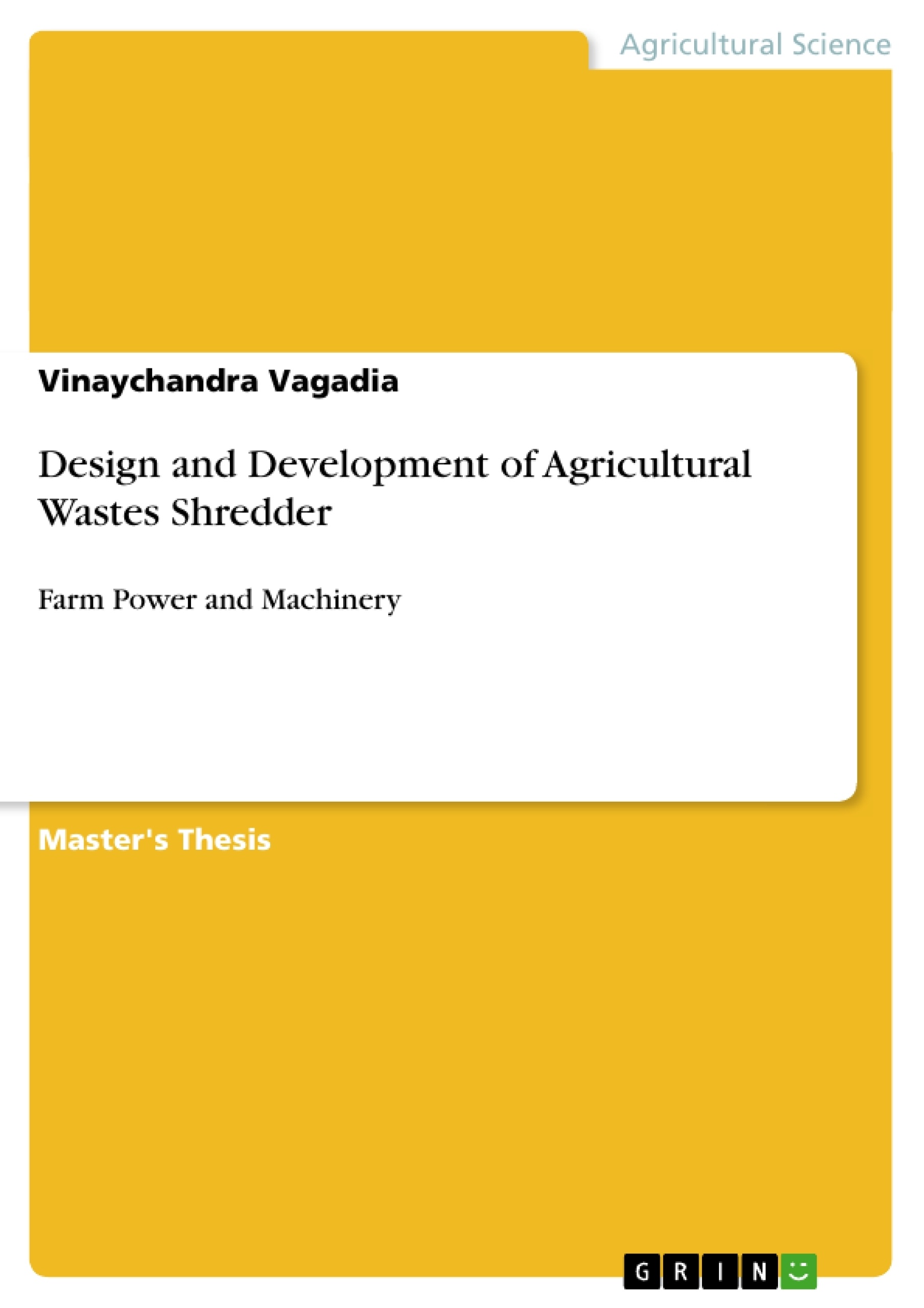It is seen that large quantities of agricultural crop residues are being wasted. A major disadvantage of most recyclable waste is their bulk i.e. it requires a large space for accommodation.
It has been observed by bio-scientists that if the waste is burnt, this affects the soil microflora, results in loss of nitrogen and organic matter. Most bulky residues need some type of pre-incorporated physical processing or shredding to facilitate their rapid decomposition and mixing with the soil.
It has been an established fact that finer particles (4 to 5 cm) decompose faster as compared to large particles.
Shredder is ideal for disposal of course leaves, garden and agricultural wastes. Such as twinges, small branches, flower stalks straw, tree pruning etc. This scientific way returns the nutrients back to the soil in natural ways. Therefore the efforts must be concentrated towards effective utilization of all the wastes.Serious efforts in this direction provide rich dividends to the farmers as well as solve the disposal problems, minimize pollution effects, open up evens for starting rural industries and self-employment or gainful employment for rural youth. It is more relevant way to avoid migration of youth from villages to the urban area in search of employment.
Despite their potential economic uses, the valuable natural resources have remained, more or less commercially unexploited. If the technologies developed are properly adopted particularly in the rural area of our country, it will provide supplementary occupation and means of uplift of the financial conditions and living standards of our villages.
Therefore besides use as fuel, it can utilized for the production of boards, animal feeds,etc.Bulk density of agricultural wastes are very low hence for the industries based on it there is a problems of handling and transportation as this increases the cost of final products. Hence the size reduction or volume reduction is very much important for effective utilization of all these sort of wastes.
Looking all these aspects and to utilize agricultural waste in industries as well as in manure effectively, the research work on “Design and development of agricultural wastes shredder” was carried out with the following objectives.
Table of Contents
- I INTRODUCTION
- II REVIEW OF LITERATURE
- 2.1 Harvesting and transporting of wastes
- 2.2 Handling and storage of wastes
- 2.3 Cutting energy and moisture content
- 2.4 Industrial use of agricultural wastes
- 2.4.1 Use in the production of boards
- 2.4.2 Use in pulp and paper making
- 2.4.3 Filler
- 2.4.4 Source of lignin
- 2.4.5 Production of micro-crystalline cellulose
- 2.4.6 Production of sugars
- 2.4.7 Production of furfural
- 2.4.8 Animal feeds
- 2.5 Use in the production of organic manure
- III MATERIALS AND METHODS
- 3.1 Physical properties of agricultural wastes
- 3.2 Design and constructional details
- 3.2.1 Design of various units
- 3.2.1.1 Cutting unit
- 3.2.1.2 Shield and concave
- 3.2.1.3 Feeding unit
- 3.2.1.4 Machine frame
- 3.2.1.5 Outlet
- 3.2.2 Selection of standard assembly
- 3.2.1 Design of various units
- 3.3 Working principle
- 3.4 Economics of machine
- 3.4.1 Cost of construction
- 3.4.2 Cost of operation
- 3.5 Performance evaluation
- IV RESULTS AND DISCUSSION
- 4.1 Physical properties of agricultural wastes
- 4.2 Design of main components
- 4.3 Selection of standard assembly
- 4.4 Cost of construction
- 4.5 Performance evaluation
- V SUMMARY AND CONCLUSIONS
- VI SCOPE FOR FUTURE WORK
- REFERENCES
Objectives and Key Themes
This thesis focuses on the design and development of an agricultural waste shredder, aiming to address the challenges associated with handling and utilizing large quantities of crop residues. The main objectives are:- To study the physical properties of castor, cotton, and pigeon pea stalks for optimal shredder design.
- To design, fabricate, and develop an agricultural waste shredder.
- To test and evaluate the performance of the developed shredder.
- The importance of size reduction for efficient waste management.
- The industrial applications of shredded agricultural wastes.
- The economic feasibility of utilizing shredded wastes for various purposes.
- The environmental benefits of composting shredded crop residues.
Chapter Summaries
Chapter I: Introduction
This chapter introduces the problem of unutilized agricultural waste and its consequences, emphasizing the need for effective waste management strategies. The thesis highlights the potential benefits of shredding crop residues, including increased decomposition rates, reduced storage requirements, and utilization for various industrial purposes.Chapter II: Review of Literature
This chapter provides a comprehensive overview of existing research on agricultural waste management, focusing on aspects like harvesting, transportation, handling, storage, and industrial utilization. It explores the physical and mechanical properties of different crop residues, including their moisture content, bulk density, and cutting energy requirements. The chapter also reviews the potential uses of agricultural waste in the production of boards, pulp and paper, animal feed, and organic manure.Chapter III: Materials and Methods
This chapter details the design and development process of the agricultural waste shredder. It describes the physical properties of selected crop residues, including castor, cotton, and pigeon pea stalks. The chapter outlines the design specifications of the machine's various components, such as the cutting unit, feeding unit, and power transmission system. It also presents the methodology for testing the performance of the developed shredder.Keywords
This thesis explores the design and development of an agricultural waste shredder, highlighting the importance of size reduction for efficient waste management, industrial applications of shredded agricultural wastes, and economic feasibility of utilizing shredded wastes. The main keywords and focus topics include: agricultural waste management, crop residue utilization, shredder design and development, industrial applications, composting, economic feasibility, size reduction, volume reduction, bulk density, moisture content, cutting energy, performance evaluation, and sustainable agriculture.- Quote paper
- Vinaychandra Vagadia (Author), 2008, Design and Development of Agricultural Wastes Shredder, Munich, GRIN Verlag, https://www.grin.com/document/272882




